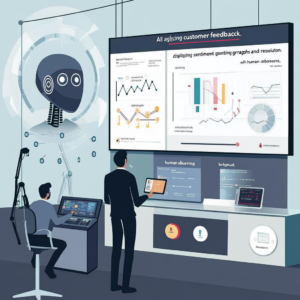
OpenAI’s $20,000 AI Agents: The Price of Genius (and Desperation)
The Curious Case of OpenAI’s $20,000 AI Agents
Imagine for a moment: an AI so powerful it could conduct exhaustive PhD-level research, streamline software development, or tackle challenges as complex as grand strategy—without ever needing to eat, sleep, or take a much-needed coffee break. Welcome to the realm of OpenAI’s latest offerings: specialized AI agents, commanding prices up to a staggering $20,000 per month. But what exactly is driving this hefty price tag? Let’s peel back the layers of hype and delve into the underlying reality.
The Digital Armory: Pricing Tiers of AI Agents
OpenAI isn’t rolling out a homogenous product; instead, they have devised a tiered lineup of agents designed to meet various professional needs:
- High-Income Knowledge Worker Agent ($2,000/month): This isn’t your typical assistant—it’s engineered for roles that require strategic thinking and analytics, like prioritizing sales leads or sifting through data to highlight key insights.
- Software Developer Agent ($10,000/month): Think of this agent as a digital coder—automating the coding, debugging, and system design processes, effectively functioning as a developer without the need for breaks or salaries.
- PhD-Level Research Agent ($20,000/month): The crème de la crème, crafted for deep dives into complex research, data synthesis, and advanced problem-solving, making it an invaluable virtual partner for researchers.
These are not mere chatbots. Each agent is crafted to seamlessly integrate with existing tools and perform autonomous tasks, delivering results that might just outshine even the most diligent human specialist[1][2][4].
The Why Behind the Price
The reasons behind OpenAI’s eye-watering pricing are multifaceted:
1. Development Costs
Creating AI with the cognitive prowess to engage in PhD-level tasks is no small feat. The expenditures on computational power, curated datasets, and skilled human oversight for accuracy and safety add up swiftly. The operational costs of maintaining such a sophisticated infrastructure find their way into the price tag borne by consumers[2][4].
2. Customization and Value
Unlike generic software, these agents undergo extensive customization tailored to specific, high-stakes applications, thus offering solutions capable of saving enterprises significant amounts on labor. A $20,000/month agent might replace a researcher with a $500,000 annual salary, making the math appealing for large companies[2].
3. OpenAI’s Financial Landscape
OpenAI’s current financial situation is rather precarious. With reported losses exceeding $5 billion in 2023, the push for a $40 billion valuation means premium pricing for specialized agents is not merely a business strategy, but a necessary survival tactic. SoftBank’s hefty $3 billion bet on these agents only underscores their perceived future importance[1][2].
4. Strategic Market Positioning
By pricing their agents at a premium, OpenAI is sending a clear message: these tools are designed for corporations and research firms willing to invest in groundbreaking AI innovations. Such pricing strategies seek to stave off commoditization and firmly situate OpenAI as the trailblazer in high-value AI solutions[2][4].
Market Sentiments: Optimism Meets Skepticism
The response to OpenAI’s premium-priced agents has been a mixed bag:
- Optimists: Advocates of these agents argue that they have the potential to transform industries by enhancing human productivity. For instance, Rocketlane’s CEO posits that a $20,000/month agent could drastically boost a $500,000/year researcher’s efficiency, possibly achieving 2-5 times greater outcomes[2].
- Skeptics: On the flip side, industry critics express doubt regarding the pricing structure. They highlight that no SaaS product has ever commanded such exorbitant fees, and there are lingering fears about overpromising—while AI agents might simplify tasks, can they truly replicate human creativity?[2].
With competitors like Anthropic’s Claude and Manus AI emerging to vie for attention, OpenAI is facing pressure to maintain its relevance. This burgeoning competitive landscape makes affordability and functionality critical factors for success[3].
Implications: AI Agents Transforming the Workforce
OpenAI’s artificial agents represent more than just a new product line; they signal a pivotal shift wherein AI is evolving from a rudimentary tool to a collaborative partner capable of handling intricate workflows. Their success will be contingent upon their ability to generate concrete value. AI expert John McNeil resonates with this sentiment: “Ultimately, OpenAI’s clients need to extract substantial real-world benefits from these agents. Only time will tell if that will happen”[2].
For now, the $20,000 agent stands as a testament to the boundless potential—and urgent financial reality—of AI technology. Whether this venture will prove to be groundbreaking or simply an exercise in monetary audacity remains an open question. What is clear is this: we are on the brink of a significant evolution in how work gets done—whether it’s a dramatic upgrade or an uncertain upheaval of traditional roles.
Want to stay up to date with the latest news on neural networks and automation? Subscribe to our Telegram channel: @ethicadvizor

